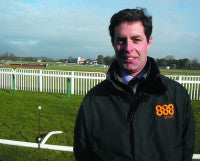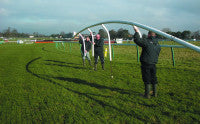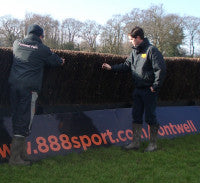Fleeced at the races!
 Fontwell Park, near Arundel, lost two meetings to the severe weather in December, despite strenuous efforts to protect the going from frost. On Boxing Day, one of the bumper National Hunt days of the year, the spotlight fell on the West Sussex course as the only one in Britain where racing might just be possible. Punters countrywide saw it as their last hope for some festive betting.
Fontwell Park, near Arundel, lost two meetings to the severe weather in December, despite strenuous efforts to protect the going from frost. On Boxing Day, one of the bumper National Hunt days of the year, the spotlight fell on the West Sussex course as the only one in Britain where racing might just be possible. Punters countrywide saw it as their last hope for some festive betting.
The whole course had been covered with fleece from 5th December, initially for the lost 7th December meeting. It was left down until 22nd December when it took fifty men to lift all of it - four just to move a single four square metre section - because it was frozen to the grass in places and covered with melted and re-frozen snow. The idea of lifting it a few days ahead of the big holiday meeting was to replace it with covers that would give greater protection.
The groundstaff would not be able to shift fleece quickly enough on race day itself in order to be ready for racing, and the black covers duly installed by Sports and Stadia Services would ensure not only a greater level of frost protection, but guarantee swifter raceday removal. Unfortunately, minus nine overnight before the Boxing Day fixture was just too much for even the covers, and the course was frozen solid beneath them. Fontwell became the last faller.

When I visited Fontwell a week ahead of its late January Jump Meeting, the country's only figure-8 course looked wonderfully green and lush and chomping at the bit for action. Clerk of the Course, Ed Arkell, wouldn't tell me how much the two very recent lost racing days cost in terms of business to the course. He simply raised his eyebrows and said 'a lot'.
There's no real way of combating the unusual conditions experienced in December. Fleece is helpful, and even though it can take fifty willing hands to remove it before the off, it is usually worthwhile. At £199 for a 250 metre roll of 12 metre wide polypropylene material, the type used for agricultural crop protection, it is often a good investment - not this time though.
Fontwell has twenty-three National Hunt meetings a year and there is racing there every month, except July. Race days can attract between four and five thousand racegoers. It is a beautiful, compact setting where every part of a race can be viewed from any single vantage point and, showing just how much it is appreciated in the racing fraternity, it has been voted the 'Best Small Racecourse in the south east' for the last nineteen years by the Racegoers Club.

Racing was first held there in 1924 and, in 2002, it was bought by the 9-course Northern Racing Group, whose other courses include Uttoxeter, Newcastle and Cheptow. The £6.5 million grandstand, opened last August, shows Fontwell is very much a prosperous and ambitious sporting venue.
Ed Arkell, who is also Clerk at the Brighton flat racing course, another of Northern's venues, and Head Groundsman, Paul Mant, showed me around Fontwell's turf - Ed, with a racing surname - pronunciation, if not spelling - if ever there was one: and Paul, now thirty years at the course, and following in the footsteps of his father, Roger, who was head groundsman for forty-four years until 2002.
Part of Ed's job is to oversee the work of Paul and his two assistants. Together they have to see that every aspect of the course adheres to the standards set down by the British Horseracing Authority. Walking the course you get a real feel of what jump racing is all about, and how this sport's turf is like no other.
In its way, keeping a racecourse in top order is rather like pitch rotation on a cricket square, especially for small courses like Fontwell where wear and tear on bends is particularly harsh. No two race meetings have the same bends, and perhaps the biggest pre-event job is moving the rails.
 Paul's two assistants were doing just that as we got to the bottom bend of the course. The reason is straightforward - to give hoof pounded stretches time to recover and enable jockeys and horses to follow the freshest line. The two bends at either end of the Fontwell course are effectively mini straights, with what are almost corners entering and leaving them. These are pretty sharp, and horses cornering cause even more lifting of the turf. The rails are moved, of course, to spread the load, but Paul has devised a dogleg shape to how they are configured to give a wider area of protection for subsequent use. It breaks the curve of the bend, but the runners and riders don't mind, and it works. You could see how, rather than follow the line of the rail, jockeys had found their own line, causing less concentrated divoting
Paul's two assistants were doing just that as we got to the bottom bend of the course. The reason is straightforward - to give hoof pounded stretches time to recover and enable jockeys and horses to follow the freshest line. The two bends at either end of the Fontwell course are effectively mini straights, with what are almost corners entering and leaving them. These are pretty sharp, and horses cornering cause even more lifting of the turf. The rails are moved, of course, to spread the load, but Paul has devised a dogleg shape to how they are configured to give a wider area of protection for subsequent use. It breaks the curve of the bend, but the runners and riders don't mind, and it works. You could see how, rather than follow the line of the rail, jockeys had found their own line, causing less concentrated divoting
The course, on a flinty band of light soil, is very free-draining, so there is no threat of waterlogging and grass thrives year round. Fixture regularity is what dictates course care at Fontwell, the more so in recent times, now that National Hunt is a year round sport.
Paul recalls that, when he first worked with his father, the first meeting of the season was always on August Bank Holiday, after at least a three month summer respite from wear and tear, effectively a time to rejuvenate the course. 
Unlike those who have to reseed seasonally, or repair localised damage albeit regularly, National Hunt groundsmen like Paul are obliged to reseed divot damage around the whole of a course after every meeting. At Fontwell, that's a painstaking task, twenty-three times a year.
Paul chooses Barenbrug Bar Sprint, a fast establishment, 100 percent ryegrass mix designed for racecourse needs. He's been using this now for nearly two years and says it works well all year round. In decent growing conditions, it's up in three or four days. He showed me how repairs to the first meeting of 2011 were already fast greening up.
Post event, he will regularly use ten tonnes of divot mix for repair work. It is made up of soil, sand, green compost and the seed. On average, 60kg of seed is sufficient for the whole course, both the outer hurdle circuit and the figure-8 used for chases. Paul says that he has had to use thirty tonnes of divot mix after a heavy going meeting, but that is exceptional.
 The repair work is certainly labour intensive. Divots are hand fork lifted, the edges trodden back, then lightly rolled before trowel filling any holes with the mixture. In the old days, it had been a job for the head groundsman - Paul and his dad before him - and just their one or two assistants. Now, Northern Racing provides a team that goes to its courses up and down the country, specifically to do the making good within 24-48 hours of racing. The turf, therefore, gets the maximum recovery time possible.
The repair work is certainly labour intensive. Divots are hand fork lifted, the edges trodden back, then lightly rolled before trowel filling any holes with the mixture. In the old days, it had been a job for the head groundsman - Paul and his dad before him - and just their one or two assistants. Now, Northern Racing provides a team that goes to its courses up and down the country, specifically to do the making good within 24-48 hours of racing. The turf, therefore, gets the maximum recovery time possible.
As we approach one of the fences, Ed tells me that they have recently all been made wider. It was a practical way of easing wear and tear by offering two racing lines, left or right, whichever he wants the field to follow. "We've also changed from the traditional portable fence to fixed, dug-in structures and simply divide the approach by using a rail," says Ed. "These jump better and maintenance time and cost is reduced."
On the outer hurdles circuit, the hurdles themselves are portable and are moved not only up and down the course, but left and right, either against the inner or outer rail or even centrally. This means that subsequent meetings do not use the same turf, which is another aid to surface recovery.
 Part of a National Hunt course groundman's job is to look after the fences and hurdles and, at Fontwell, Paul has four hurdles on the outer circuit and, on the jump course, he has six plain fences and an open ditch to maintain. Birch brush is the main constituent part, which surprisingly, Ed says, is getting hard to get. Premier courses, like Cheltenham, have green plastic frontages to fences, backed by birch. At Fontwell, it's birch through and through.
Part of a National Hunt course groundman's job is to look after the fences and hurdles and, at Fontwell, Paul has four hurdles on the outer circuit and, on the jump course, he has six plain fences and an open ditch to maintain. Birch brush is the main constituent part, which surprisingly, Ed says, is getting hard to get. Premier courses, like Cheltenham, have green plastic frontages to fences, backed by birch. At Fontwell, it's birch through and through.
Paul cuts the course up to three times a week. He used to do it by gang-mowing, but, three and half years ago, switched to using a front-mounted Votex rotary with cuttings blower. Its four metre cutting width is ample for keeping things in trim.
Cutting height is mostly around the four and half inch mark (115mm); a little lower in spring to toughen up the sward and sometimes a little higher over the winter months.
Although December was a step too far, Paul says he is not heartbroken if a winter is cold and harsh provided, of course, it doesn't disrupt fixtures. "Frost aids decompaction and kills a lot of the bugs and often, after a thaw of snow, we get a pleasant greening up flourish," he says.
Ed is naturally more anxious about cold winters because of the commercial havoc they can bring, but he concedes that a little pain can be a big gain to the course itself. "You have to take the rough with the smooth," he says," as long as the rough bits are well before race days."
